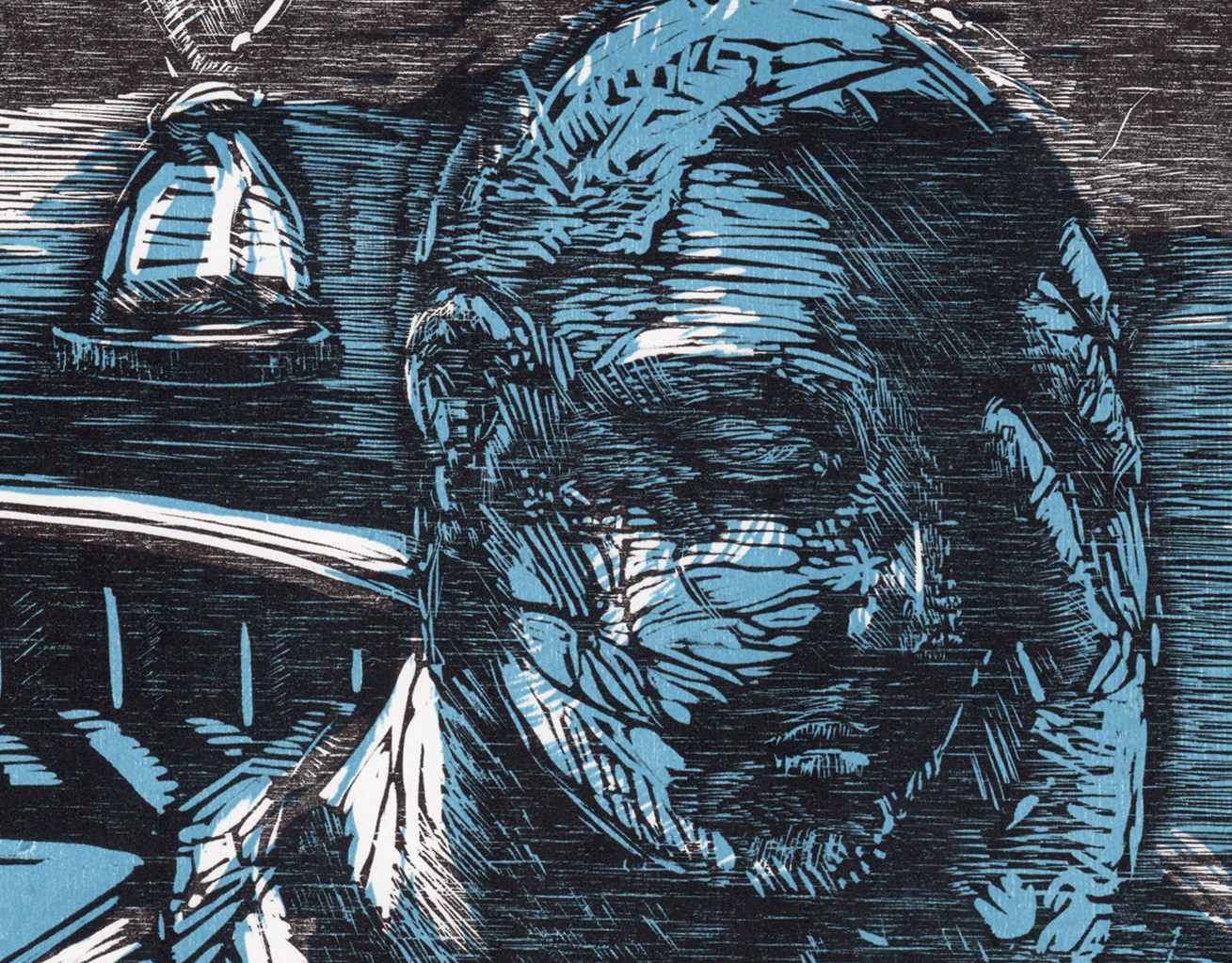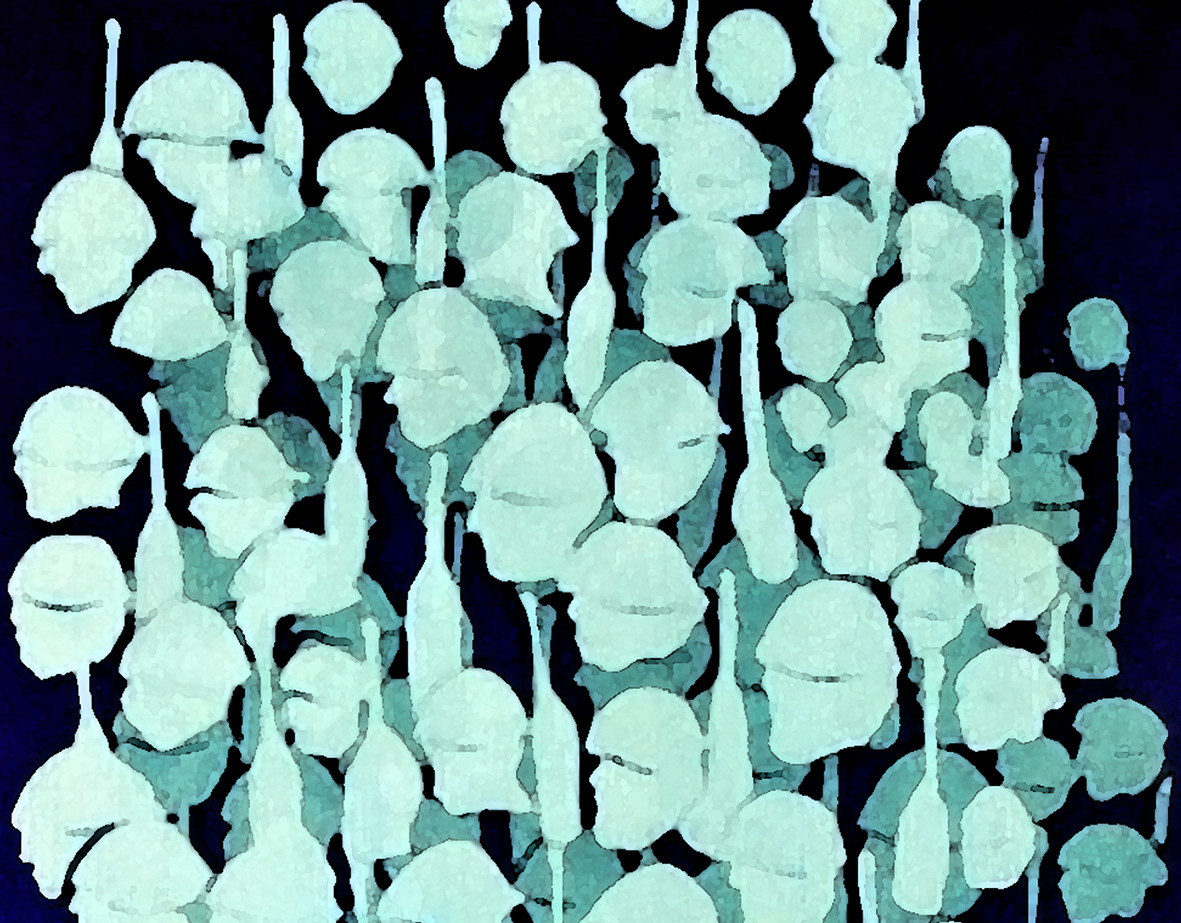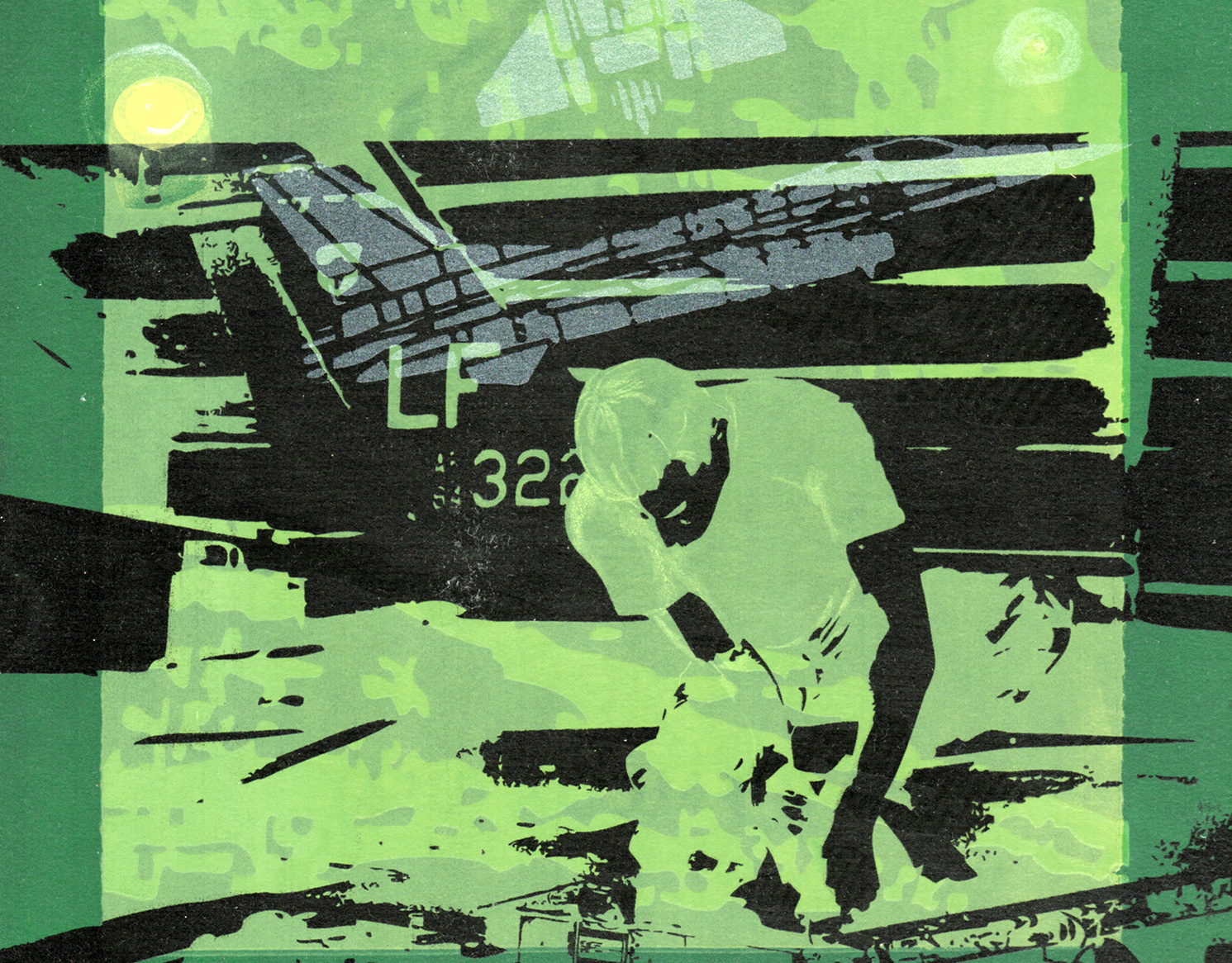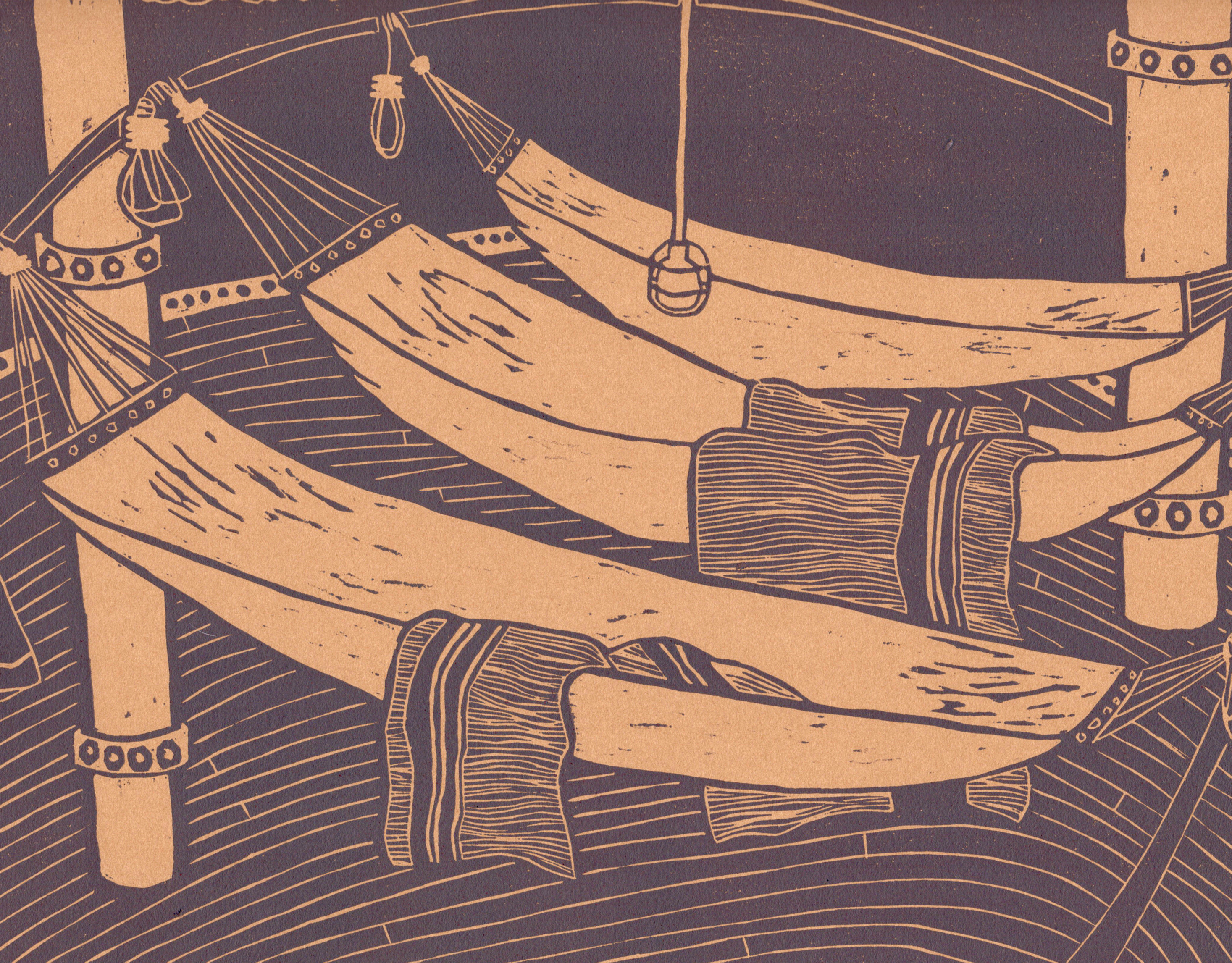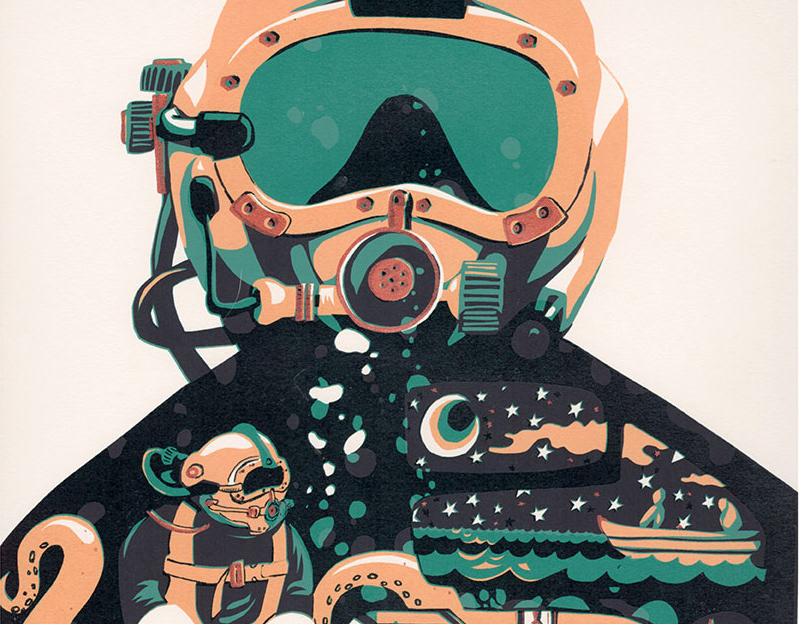Mountains and Radios | Artist: Megan Merckx | Veteran: Luke S., US Army
Mountains and Radios
Artist: Megan Merckx
Veteran: Luke S., US Army
Media: Photo lithograph
“I Always Find Myself Here” comes from Luke’s travels around the world and how he always surrounds himself with two things, mountains and radios. While he was stationed in Korea in the 90s he worked as a commissioned officer working specifically with radios. The image is a reflection of how remote the communication must have been while he was in the mountains in Korea.
All Around Eyes | Artist: Michael Laurito | Veteran: Erik W., US Army
All Around Eyes
Artist: Michael Laurito
Veteran: Erik W., US Army
Media: Collagraph
Erik was a tank commander in the Persian Gulf War. He described it as one of the most life changing moments of his life. The act of being a soldier became mystic, changing his perspective completely. He told me, “it was being enlisted or being in jail.” Walking past a booth one day, he enlisted, and left for basic training. And less than a month later, he was told he was going to be a part of the Gulf War.
This piece is about his experience in war, and how it changed his life. Being in a tank made him feel like a hero. He was a warrior, and he was doing something important.
It's about vision and idealism. As a tank commander, he was the only crew member with full 360 degree vision. He instructed the other crew how to move and fight. In war he was the eyes, and this experience of fighting gave Erik purpose. It gave him a new 360 degree perspective for the rest of his life.
What’s Important | Artist: Ethan Stayer-Bauer | Veteran: Gary B., US Army
What’s Important
Artist: Ethan Stayer-Bauer
Veteran: Gary B., US Army
Media: Screenprint
“What’s Important” is meant as a look into Gary’s heart and what he holds dear. The border is composed of sayings and values he stands for. A common theme between them is togetherness and fairness. I wanted to capture the importance of his family, his career, and the values he carries. Finally, I included the American flag to symbolize the freedom and lessons that his military experience provided to him. The three components within the border are his family, his business, and his home. I depicted his family as the ground of the piece because of their importance in holding everything else up. We see the Remax balloon comfortably floating in the air to symbolize where his business is now. The work has been done to get it off the ground and now it just needs to navigate and look out for “storms”. An opportunity which allowed for my veteran to become the wonderful hard working person he is. I thought encapsulating what is dear to him with the values he carries himself with would be a powerful visual and emotional statement.
Memories of Compassion | Artist: Raven Higginbotham | Veteran: Peter B. US Army
Memories of Compassion
Artist: Raven HigginbothamVeteran: Peter B. US Army
Media: Woodcut
“Memories of Compassion” is inspired by the stories shared by Peter B. during an interview. Peter was adopted into a family with a strong military history, enlisted in the US Army at age 17, and began duty days after his 18th birthday. Peter shared a story of his time in Afghanistan, how his unit would often do patrols through grape fields, pick the fruit off the vine, and pop them into their mouths. I used grapes as a symbol to distract viewers from the reality that he was at war, alluding to the unconscious technique our brains typically utilize when a person experiences significant trauma. As he had enlisted in the infantry, Peter had several essential jobs. Primarily, he would sweep the roads ahead for hidden explosive devices, IEDs; he was responsible for keeping his platoon safe from the IEDs on missions. The figures are reminiscent of Peter's action to save his unit from the IED that detonated, featured in the background. What immediately stood out to me was Peter's selflessness not only on the field but also after he was discharged. After his service, Peter has continued to support the veteran community; by providing peer support at the NHAW R&R House in Pewaukee, Wisconsin.
Where You Have Been | Artist: Kaylee Builer | Veteran: Karla, United States Air Force
Where You Have Been
Artist: Kaylee Builer
Veteran: Karla B., United States Air Force
Media: Screenprint
I come from a family of veterans, so for me this was a very personal project. The veteran whose story I illustrated is Karla, my mother. During her time in the military she traveled the world, worked on launch at Cape Canaveral, and was awarded honors for her service. After conducting multiple interviews with her, I ideated the image, and rendered it through screen printing. Where You’ve Been is really a letter to my mother where I honor the momentous things she was a part of, as well as celebrate the places she traveled during her service. I had the unique opportunity of making a piece to tell my moms story, and the pride and love I have for this person in my life is what I depicted.
Two Sides of a Story | Artist: Khalajia Hannah | Veteran: Tara V., US Army
Two Sides of a Story
Artist: Khalajia Hannah
Veteran: Tara V., US Army
Media: Screenprint
Tara served in the US Army in Germany. I was very excited to be paired with her because I am currently serving and I am also a student. I felt very connected to hearing Tara’s stories. We both share a sense of being excluded from our peers because it sometimes feels like you can’t talk to someone who isn’t knowledgeable about the military experience. Whilst hearing the amazing stories from Tara, I wanted to portray myself in the print as well.
Gallant Operations | Artist: Olive Paul | Veteran: Matt C., US Army
Gallant Operations
Artist: Olive Paul
Veteran: Matt C., US Army
Media: Screenprint
Gallant Operations is a story of leadership, respect and responsibility. Captain Matt C. was stationed in Kuwait in 2020 when COVID-19 broke out worldwide. Left in charge of the department of public works and majority of operations on base when hundreds of contractors were sent home, he stood his ground and provided everything he could for his brothers in arms. His efforts were rewarded with respect and the privilege to serve his country and fellow armed service members in Iraq and now Africa.
What You Have Been Missing | Artist: Penelope Padilla | Veteran: Edgar G-B., US Army Reserves
What You Have Been Missing
Artist: Penelope Padilla
Veteran: Edgar G-B., US Army Reserves
What You Have Been Missing
Media: Laser Cut Relief Print
Serving in the 301st PSYOP company in Iraq post 9/11, Edgar had joined the Army Reserves in order to pay for his degree in art education. While his experiences relied mostly in running and getting supplies, in charge of primarily ACU’s and FOB’s, a fear lingered in his mind. Serving under Don’t Ask Don’t Tell, Edgar feared he would be dismissed for identifying as a gay man, but also refused to dodge his service in favor of just keeping the secret to himself, which he did. Now, Edgar is able to be proud of himself and who he is, while working as a high school art and theater teacher in Chicago Illinois.
A Mother’s Duty | Artist: Ruby Stroebel | Veteran: Erica N., US Army
A Mother’s Duty
Artist: Ruby Stroebel
Veteran: Erica N., US Army
Media: Screenprint and photolithograph
My conversations with Erica, a US Army veteran, focused on her time away from home during her deployments and how she stayed connected with her young daughter. Within the separate panels, the focus is upon three distinct periods of time when Erica was deployed in her daughter’s life. On her first deployment away from her daughter in Kuwait, Erica would send home pictures she drew, and her daughter would send her drawings back. During our conversation, she told me her arms ached from not being able to hold her daughter. Her daughter sent her various items during her next deployments, including a flat stanley doll and Harry Potter books. The idea for the composition was to illustrate their profound relationship through the years.
Desert Mornings | Artist: Ryan Kane | Veteran: Erik S., USMC
Desert Mornings
Artist: Ryan Kane
Veteran: Erik S., USMC
Etching
Erik is a United States Marine who served for 20 years in the Fox Company of the 2nd Battalion, 24th Marines. Deployed in Fallujah and Yusufiya during the Iraq war, Erik frequently woke up early to watch the sunrise over the desert. Previously carrying a disdain for the intrusive sands and harsh dust storms, he quickly developed an appreciation for the arid landscape during these times of momentary solitude. After returning to Wisconsin, Erik continues to imagine himself in the desert gazing into the sun coming up over the city skyline–the silhouettes of prayer towers casting beams of light that spread over the rolling dunes.
Research Project Portfolio
Kaylee Builer
For this project, the topic I focused on was the history of women's rights in the military. In this print, I depicted a timeline of some key points in times that show the development of women's rights. Then, I depicted different roles women had in the military throughout history. For the initial black and white values I utilized photolithography and then added a transparent green shade using screen printing.
DeSimone, Danielle. “Over 200 Years of Service: The History of Women in the U.S. Military.” United Service Organizations, The USO, 28 Feb. 2023, https://www.uso.org/stories/3005-over-200-years-of-service-the-history-of-women-in-the-us-military.
“How Women Fought Their Way into the U.S. Armed Forces.” History.com, A&E Television Networks, https://www.history.com/news/women-fought-armed-forces-war-service.
Lori Robinson and Michael E. O’Hanlon. “Women Warriors: The Ongoing Story of Integrating and Diversifying the American Armed Forces.” Brookings, Brookings, 6 Jan. 2021, https://www.brookings.edu/essay/women-warriors-the-ongoing-story-of-integrating-and-diversifying-the-armed-forces/.
“Women, Regardless: Understanding Gender Bias in U.S. Military Integration.” National Defense University Press, 9 Jan. 2018, https://ndupress.ndu.edu/Publications/Article/1411860/women-regardless-understanding-gender-bias-in-us-military-integration/.
“Women, Regardless: Understanding Gender Bias in U.S. Military Integration.” National Defense University Press, 9 Jan. 2018, https://ndupress.ndu.edu/Publications/Article/1411860/women-regardless-understanding-gender-bias-in-us-military-integration/.
Khalajia Hannah
For the research of this particular print, I wanted to research the hair standards for men in the military. According to AR 670-1 under hair standards, I think the standards don’t apply fairness to both genders. I wanted to portray the appearance of a male figure with the right image of what a male’s appearance is to look like and also I included some things that aren't permitted. Because I believe in professional appearances this army regulation code basically strips away from the importance of hair in many races. Everyone’s skin is different and for men shaving profiles are the only way (if documented) that men could continue to grow out their facial hair in comparison to the hair on their crown.
Raven Higginbotham
Women played a vital role in America during the First World War of 1914, working in hospitals and factories and participating in military organizations. "Camopidea" was Inspired by the work of the forgotten, military-specialized division known as the Women's Reserve Corps. The corps comprised several female artists from around America who joined the National League for Women's Service and trained to serve in the Camouflage Department of the US Navy. Women in the corps in New York used Central Park as a laboratory to test their camouflage designs.
The inspiration for this piece was taken from a photograph of a woman standing atop a hill wearing the "Rock suit" design, a head-to-toe linen outfit covered in sporadic patches of dried grass. The pattern on the rock suits blended in well with both rocky and forested areas. I felt it was most successful in rocky terrain; when creating this composition, the deserts of Afghanistan came to mind, mainly due to my recent work with the military veteran Peter Borucki. Using a limited color pallet, I created an 8''x10" bleed screenprint that depicted figures wearing full-body linen suits with patterns that mimicked their environment. The figures are positioned in different areas of the piece to show how successful the suits were in different backdrops.
Makala Mott
My topic was Civil War music. I wanted it to look like an old faded music poster, with some gaps and ‘messy’ line work. The instrument on the border is called a Fife and the instrument in the center and being held is called a Bugle. One of the most famous songs from the time was “John Brown’s Body”. I didn’t want anything to line up perfectly to represent how imperfect the war was.
Olive Paul
In WWI, the Royal Navy made use of psychedelic, vibrant, optical-illusion prints to camouflage warships and merchant ships from German U-boats. These complicated patterns made it difficult to detect the speed and direction of ships from the periscope view of a submarine. This print highlights the unique dazzle designs of the HMS Argus, HMS London, and HMS Nairana as they were in the early 1900s.
Ryan Kane
Mitchell Red Cloud, Jr. is a heroic figure in both Ho-Chunk and American societies. Born and raised in Hatfield, Wisconsin, he enlisted in the Marines towards the end of World War II and soon thereafter joined the US Army to fight in the Korean War. After committing a courageous act that posthumously earned him the Medal of Honor in 1951, Red Cloud Jr. went on to live in the public memory of Americans and Ho-Chunks alike. Much cultural significance surrounds the young warrior as a result of his honorable service. A Wisconsin historical marker erected in 1952, a temporary army base in South Korea, a Navy cargo ship, as well as an annual Pow-Wow held by his Ho-Chunk community all celebrate Red Cloud, Jr.’s bravery and are brought together in this print as a commemoration of his life.
Megan Mercks
The WASPs were a women-led group of pilots that flew during WW2. These women were not allowed to serve in the military at this time but were able to fly service missions delivering supplies to soldiers. Due to the fact that they were not technically in the military, they were not able to get the same benefits as the men serving. Finally, in the late 1970s, the WASPs were finally gifted the status of World War II veterans. These air pioneers paved the way for today's female pilots of the US Air Force.
Ruby Stroebel
The FUDS program has finally begun the cleanup of the hazardous waste left by the US military all over Alaska, specifically in the Aleutian Islands. Alaska was used as a naval refueling station during WWII, and a number of military sites were never cleaned up. Many contain harmless remnants such as abandoned pill boxes, quonset huts, and old machinery, but some have remaining hazardous waste such as underground storage tanks that were used to store petroleum and unexploded munitions. The cleanup is just in time for the Willow Project to begin drilling oil throughout Alaska.

